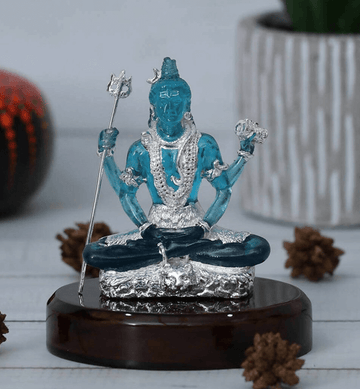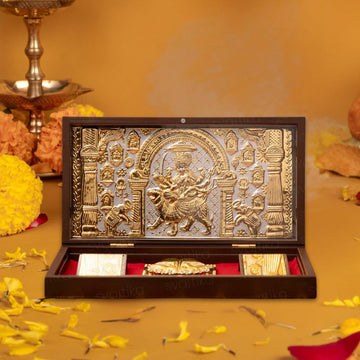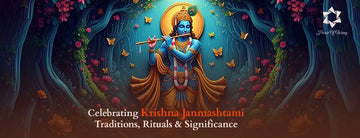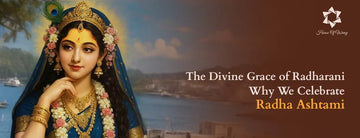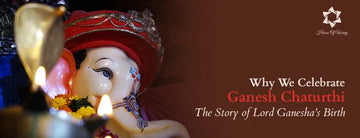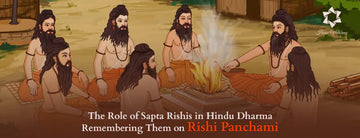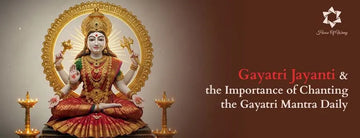You may have heard of Lord Krishna — perhaps when your grandmother scolded you for being naughty like Kanha, or in bedtime stories about our beloved Makhan Chor. But do you know the significance of Krishna Janmashtami in our lives today?
In a world that often feels chaotic, the birth of Krishna reminds us that light can arise even from the heart of darkness.
This blog will take you through the rituals, symbolism, and spiritual teachings of Janmashtami, from fasting and midnight abhishekam to what Krishna teaches us in the Bhagavad Gita.
If you want to know why it is being celebrated, this is for you.
The Birth Story of Lord Krishna: Mythological Significance
The birth of Lord Krishna is among the most beloved stories to bhakts in Hindu mythology. He was born around 5,000 years ago in Mathura to Devaki and Vasudeva. Lord Krishna was born in a prison cell; the evil King Kansa (Devaki's brother) imprisoned Devaki after hearing a prediction that said her child would kill him. To stop this from happening, King Kansa had earlier killed six children of Devaki and Vasudeva.
While Kansa Mama was plotting to kill Krishna, a divine energy guided Vasudeva to escape the jail and carry the newborn saviour of the universe, Lord Krishna. Vasudeva carried baby Krishna on his head in a basket and crossed the Yamuna River to reach Gokul. The night was darker than usual, but there was a divine light encouraging the father to reach the destination. The same night is now celebrated as Krishna Janmashtami.
But why does Krishna’s birth matter?
- Krishna came to the world for a reason. His birth represents the triumph of good over evil. (धर्म की अधर्म पर विजय).
- His life delivers a message of bravery, true friendship, and unconditional love.
-
The Janmashtami story from the Bhagavad Gita is rich with spiritual themes, where Lord Krishna shares timeless lessons for living.
Why Krishna Janmashtami Is Celebrated Across India
Krishna Janmashtami is one of the festivals when devotees celebrate it with love and devotion at home. It is celebrated across India, as it brings divine energy, joy, and peace. Bhakts celebrate it usually at midnight, and it is enjoyed as if a baby has just been born.
But why is only the birth of Lord Krishna honoured and celebrated, and not any other God?
The answer is very simple: devotees respect and offer prayer to each God, but they revere Krishna as their child. Lord Krishna is a mischievous Makhan chor for Yashoda, or a guru for Arjuna in the Mahabharata, or the eternal beloved of Radha. Krishna has a role in each of our lives, and that is why the birth of Lord Krishna is celebrated as Janmashtami.
- In Mathura and Vrindavan, Janmashtami is a homecoming. Decorating temples, performing rituals, Raslilas, and spiritual parades of devotion take place across the town.
- In Maharashtra, the Dahi Handi Festival shows the playful character of Krishna with human pyramids.
- In the South, footprints of baby Krishna are drawn on doorsteps to welcome him into homes during Janmashtami celebrations.
- In Gujarat, Rajasthan, and Odisha, devotional singing, folktales, and the midnight birth ceremony of Lord Krishna are celebrated in traditional wear.
Date, Timing, and Astrological Importance of Janmashtami
Janmashtami 2025 date is on August 16th, when devotees observe the Krishna Janmashtami fasting throughout the day, and the celebrations are held at midnight.
Astrological Importance:
- Janmashtami is celebrated before the Ashtami (8th day) of the Krishna Paksha (waning moon) in the month of Bhadrapada.
- Lord Krishna is said to be born at midnight when the Rohini Nakshatra was ruling, which is an auspicious star for beauty and strength.
-
Krishna was born under a rare planetary alignment, creating an environment for spiritual growth and the experience of his divine qualities.
Traditional Rituals and Fasting Practices Observed
In Hinduism, devotees celebrate Janmashtami by singing Krishna bhajans and songs and dancing. And, one of the most spiritual elements of this festival is the Krishna puja on Janmashtami, which helps devotees connect deeply and share in Lord Krishna’s divine energy.
Some of the ancient Janmashtami rituals and traditions include:
- Fasting: Most devotees observe nirjala vrat (without water) or phalahar (only fruits).
The Janmashtami pooja vidhi includes:
- Performing Abhishekam by bathing the idol of Lord Krishna with milk, ghee, honey, and water.
- Dressing the idol in fresh clothes, ornaments, a bansuri (flute), and tilak.
- Offer little Kanhaiya some tulsi leaves, Makhan, sweets such as panjiri, and fruits.
- Bhakts also chant the 108 names of Lord Krishna for peace of mind and soul.
Midnight Celebrations and Krishna Abhishekam Explained
We have all heard the Krishna katha from our grandmother during celebrations. On the night before Janmasthmi, women dress up, decorate their house with Krishna Idols, jhula and flowers. People get together for a celebration. Kids dress up as Lord Krishna and Radha Rani.
But do you know why all of these celebrations are done one night before Janmasthmi? The midnight hour is traditionally considered the birth hour of Krishna and is full of divine energy.
Midnight ceremony includes:
- Abhishekam - Yes, even in midnight celebration, bathing of the idol is done with holy water, milk, curd, honey, ghee, and tulsi leaves, known as Panchamrit. While chanting sacred Vedic mantras.
- Jhulan (swinging ceremony) - The baby Krishna idol is placed into a decorated cradle and swung gently to celebrate the divine birth.
- Aarti and Bhajans - Devotees sing happy songs and perform aarti to welcome Krishna to their home.
The spiritual meaning of Janmashtami is to surrender and celebrate. It signifies that divine grace only enters our lives when we empty ourselves of ego and lead our lives with love and devotion.
Dahi Handi: The Symbolism and Regional Variations
Dahi Handi festival is popularly celebrated in various regions of India, especially in Maharashtra. A pot (handi) is hung up at a height using a rope. It is filled with curd (dahi), makhan and candies.
A group of men (Govindas) build human pyramids to break the pot, while women (Gopis) watch them play dahi handi and encourage them to win.
This celebration reflects Lord Krishna's playful role as the Makhan Chor.
Now let's dive deep into the significance of celebrating Dahi Handi:
- The celebration represents unity, teamwork, and devotion as the Govindas unite together as a team to win.
- Spiritually speaking, breaking the pot placed at the height represents overcoming ego in our lives and reuniting to reach the heavenly moments.
In different parts of India, you will find regional variations of the Dahi Handi Festival, such as Uriyadi in Tamil Nadu and Makhan Handi in Gujarat, which also reflect and celebrate Krishna's mischievousness and love.
Popular Bhajans and Mantras Dedicated to Lord Krishna
As we all know, music helps us heal our souls and gives us peace of mind. It is also the main element of the Janmashtami celebration. People usually organise bhajan kirtans on the night before the Janmastmi. They sing devotional songs or bhajans, recite kathas from the Bhagavad Gita.
Here are some beautiful bhajans and mantras:
- "Achyutam Keshavam" praises the divine presence of Krishna through his sacred forms.
- "Govind Bolo Hari Gopal Bolo" is sung to Krishna with innocence and childlike love.
- "Om Namo Bhagavate Vasudevaya" is a powerful Vedic mantra from the Bhagavad Gita.
Decorating Krishna Idols and Homes During Janmashtami
Decorating Lord Krishna Idols and the home in the Janmashtami is a common practice across India. It creates spiritual space for Lord Krishna and welcomes his divine energy into the home.
Some examples of Janmashtami celebrations include:
- Decorating a jhula (cradle) for baby Krishna.
- To replicate Vrindavan, flutes, peacock feathers, cows, and handis are kept near the jhula.
- Women make Rangoli and flower garlands to welcome Lord Krishna.
- Diyas are lit for brightness in the home with divine presence.
- Bal Krishna idols are dressed in silk clothes, adding a mukut (crown), a bansuri (flute), and other ornaments.
Want to explore more decoration items and Janmashtami essentials? Visit the House of Wemy.
Teachings of Lord Krishna from the Bhagavad Gita
The Janmashtami story from the Bhagavad Gita offers timeless wisdom for people at every stage of life.
Core teachings:
- Do your duty (dharma) without being greedy for results - Karma Yoga
- Surrender yourself to the divinity with trust - Bhakti Yoga
- Keep a balance between your mind and emotions - Gyaan Yoga
These teachings encouraged people not to abandon their worldly duties for spirituality, but to engage divinity in their lives with positivity, love and understanding.
How is Krishna Janmashtami celebrated Worldwide?
You don't need to visit a temple to feel Krishna's presence. A prayer in your home can be as divine as a temple.
A few ideas on how to celebrate Janmashtami?
- Clean and decorate a small divine baby Krishna Idol.
- Observe a fast and prepare sattvic meals to offer to Lord Krishna.
- Do Abhishekam at midnight.
- Read or listen to Krishna's stories or the Bhagavad Gita.
- Include children in stories or bhajans to teach them the significance of Janmastmi.
Final Take
Krishna Janmashtami is not just a celebration of Lord Krishna's birth. Janmashtami, with its many traditions, uplifting rituals and teachings in the Bhagavad Gita, inspires us to live our life's journey with courage, a sense of devotion, and a spirit of selflessness.
Remember, welcome Bal Krishna with love and devotion, bring home Lord Krishna Idols, Puja essentials from Wemy. Perform Puja, fast, sing bhajans, or simply be with family and friends.
May Lord Krishna bring peace, happiness, and spirituality to you.

